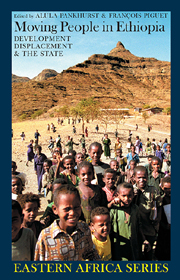Book contents
- Frontmatter
- Contents
- Acknowledgements
- Acronyms
- Glossary
- Notes on Contributors
- Preface: An Original Contribution to Country-wide Displacement Analysis
- Foreword by Alula Pankhurst & François Piguet
- Map
- Part I INTRODUCTION
- 1 Migration, Resettlement & Displacement in Ethiopia
- Part II THEORETICAL & INTERNATIONAL PERSPECTIVES
- Part III DEVELOPMENT-INDUCED DISPLACEMENT
- Part IV THE EXPERIENCE OF STATE-ORGANIZED RESETTLEMENT
- Part V THE DILEMMAS OF REFUGEES, RETURNEES & DISPLACED GROUPS
- Part VI CONCLUSION
- Bibliography
- Index
- EASTERN AFRICAN STUDIES
1 - Migration, Resettlement & Displacement in Ethiopia
from Part I - INTRODUCTION
Published online by Cambridge University Press: 05 April 2013
- Frontmatter
- Contents
- Acknowledgements
- Acronyms
- Glossary
- Notes on Contributors
- Preface: An Original Contribution to Country-wide Displacement Analysis
- Foreword by Alula Pankhurst & François Piguet
- Map
- Part I INTRODUCTION
- 1 Migration, Resettlement & Displacement in Ethiopia
- Part II THEORETICAL & INTERNATIONAL PERSPECTIVES
- Part III DEVELOPMENT-INDUCED DISPLACEMENT
- Part IV THE EXPERIENCE OF STATE-ORGANIZED RESETTLEMENT
- Part V THE DILEMMAS OF REFUGEES, RETURNEES & DISPLACED GROUPS
- Part VI CONCLUSION
- Bibliography
- Index
- EASTERN AFRICAN STUDIES
Summary
Migration between regions and states has been a constant feature of history. However, towards the end of the twentieth century, the importance and pace of migration increased dramatically with population dynamics, political and technological changes, and ease of transport and communications. Migration can thus be considered a paradigmatic condition of modern times (Castles and Miller 1993), raising crucial issues to do with rights and identities, in a context of the development of fortress mentalities seeking to restrict migration. Forced migration is becoming an increasingly important aspect or form of migration (Soguk 1999). However, the distinction between forced and voluntary migration is becoming more complex and problematic, the interlinkages between the two are becoming more significant, and the analytical validity of the dichotomy may be questioned (Van Heer 1998).
This introduction has the aim of setting the issues of migration, resettlement and displacement within a broader historical and geographical context within Ethiopia and the Horn of Africa. We suggest that the dynamics between highlands and lowlands and the involvement of the state are often crucially overlooked dimensions. At the same time, we draw attention to the international literature on the central issues linking debates within the Ethiopian context with global concerns.
- Type
- Chapter
- Information
- Moving People in EthiopiaDevelopment, Displacement and the State, pp. 1 - 22Publisher: Boydell & BrewerPrint publication year: 2009



